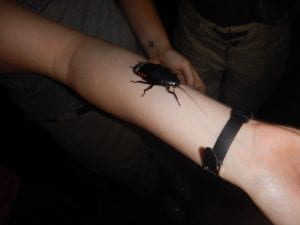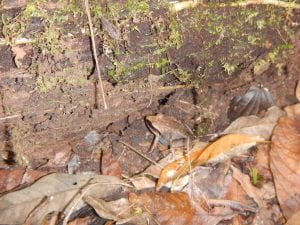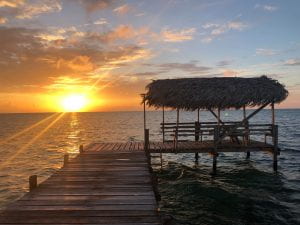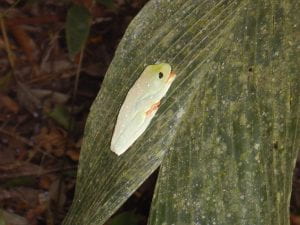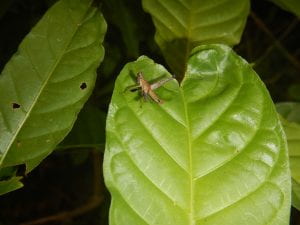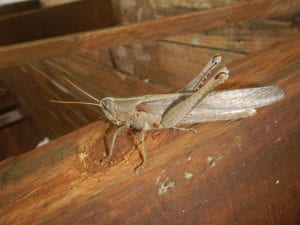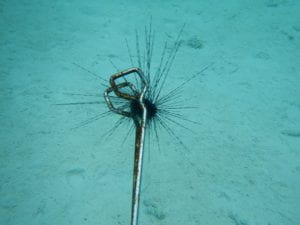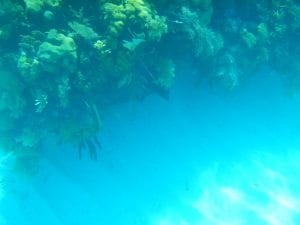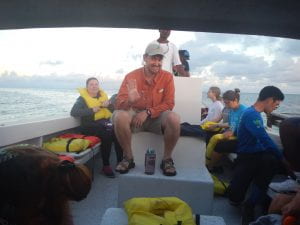Now that I am home, I can say that I do not miss waking up to more bug bites, and just walking outside and not having bugs bite me is nice. I woke up today and had a bagel, so back to the normal meals, and no more Belize food *cries*.
Things I have learned on this trip: Lots of different species in both the rainforest and coral reef ecosystems that are well hidden unless you take a good look at it (camouflage is next level here). Ants have such complex nests, a great “highway” system, great communication, and a great protection of their nest. These ants depend on the fungus and the ants will do anything to protect it and the queen. Marine debris continue to push onto islands and many things can be done (avoid single use plastics, don’t litter, recycle, etc.) to prevent marine debris from entering our oceans. Save our planet was a big point emphasized on our last day at Glover’s.

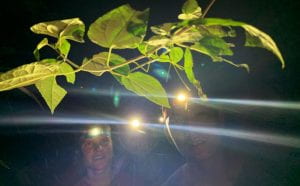
Picture 1: Featuring the well hidden stick-bug (Phasmatodea) and Bella!
Picture 2: My face in amazement.
Similarities between Coral Reefs and Tropical Rain forests include: Tropic distribution, nutrient poor environment, year-round growing season, intense competition for space, high structural complexity, and many symbiotic relationships. Both ecosystems also are nutrient poor, but they overcome this by finding nutrients in their own inhabitants. Nutrient cycling takes place by decomposers or in coral reefs, by corals and sponges. Both ecosystems are not only threatened by natural dangers such as the changing environment but also direct human threats. Whether we like it or not, we shape the environment and the environment shapes us. With all of these similarities, the similarities are present due to the pressure in which these many species have. These species are trying to survive and only the fittest survive, thus more evolutionary changes, which leads to more diversification.
Yet these two share similarities, they also share differences. I have noticed that the differences between the two ecosystems is likely to be due to differences in the the degree of past disturbances than to differences of the competitive displacement during the recovery from the disturbances.
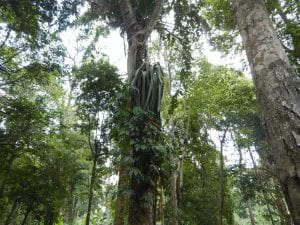
Picture: Image showing many epiphytes and example of competition for space.
Since the tropical rain forest ecosystem has vast amounts of trees, most of the animal life here are highly evolved for life in trees, and so have many plants! I have observed this many time since my taxonomic group was epiphytes and they grow all along trees to get sunlight.
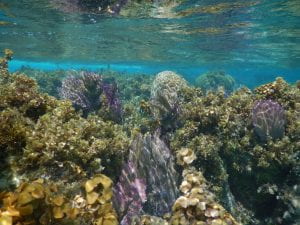
Picture: Coloration of fish makes them hard to find!
I have noticed that the reef contains many small nooks among the coral, many fish have adapted a body type to be able to fit in these small crevices. Instead of being built for speed (don’t get me wrong, these fish are still fast), reef fish seem to be flatter and more maneuverable. These fish are also brightly colored for both camouflage and mating (very very cool coloration!)
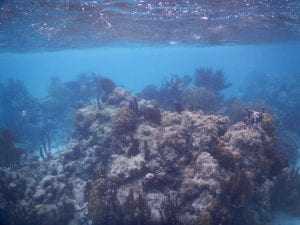
Picture: Image showing many corals and and example of competition for space.
This course exceeded my expectations in many ways. Before coming into the trip, I thought this little 3oz bottle of bug spray would last me the whole trip, and boy was I wrong. I thought snorkeling would be hard, and boy was i wrong. It is so much easier than swimming since you are constantly afloat (that is if you breathe). I did not know how much fun we would have throughout the day, yes we did do lots of work, but it was a great balance of fun and work!
It is so hard to just pick one thing that stood out to me throughout this course. I had many highlights of the course such as: Dr. Solomon showing us around a leaf cutter ant nest, Brendan and Keegan fighting, Amanda’s crazy quick identification of corals, and obviously the food. Least favorite parts would have to be just getting sunburnt and all the bug bites, but hey it’s nature, so I should not complain since I already miss is and I would in fact go back and do it all again (but this time MORE BUG SPRAY).
Things I will remember 5 years from now: Brendan’s mating call, all the bug bites I accumulated on day one at Glover’s, holding the boa constrictor, Keegan and Brendan constantly lying to me, Kaela’s pizza story, “Turn around” Brendan’s newest single, and HOW THE FOOD IS SO GOOD.
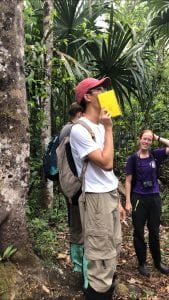
Picture: Brendan’s mating call (what a man).
Wow team epiphytes for the win. Will definitely miss all the times were we tried hand signaling under water, but hey we tried. On our last few data collections, we did use hand signals, but it was mostly, “Hey Pierce got get the quadrat” or “Are you okay” to even IM CHILLIN as in “I’m good”. Communication is key and under water communication is harder yet a great experience, or as Pierce would say “A good time”.
Most important section alert!! FOR FUTURE TFB’s: You guys are for a treat! This class as a whole was so much fun, and EVERYONE was so nice and welcoming. Things you should triple check before you leave: Passport, LOTS of: Bug spray, baby oil, and sunscreen, long sleeve shirts, and a hat. This will definitely help with all the ticks at Las Cuevas and the Death of the mangroves at Glover’s. Come ready to be tired 24/7, and ready to learn since you will definitely learn a lot!
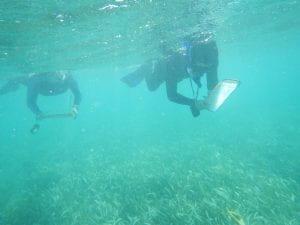 Team Epiphyte
Team Epiphyte
Thank you guys for all the great memories. Oh and thank you to the fans that read the blogs! You guys are the Best!!
Epiphytes
- Black Orchid (Encyclia cochleate)
- Strangler fig (ficus aurea)
- Green sword (Werauhia gladioliflora)
- Lianas
- leaf like lichens (Flavoparmelia caperata)
- Scoliosorus ensifmis
- Cochlidium Serrulatum
- Elaphoglossum latum
- Radiovittaria stipitata
- Vittaria
- Trichomanes
- Asplenium formosum
- Alansmia sensilis
- Ahaecistopteris
Annelids
- Horned feather duster (Spirobranchus giganteus)
- Bearded fireworm (Hermodice carunculate)
- Spaghetti worm (Eupolymnia crassicornis)
- Split crown feather duster (Anamobaea orstedii)
- Social feather duster (Bispira brunnea)
- Medusa worm (Loimia medusa)
- Shy feather duster (Megalomma sabellida)
